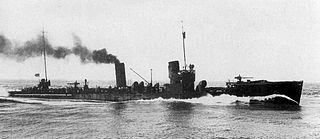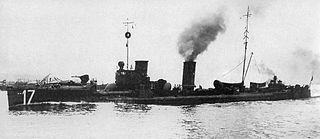
SMS S36 was a 1913 Type Large Torpedo Boat of the Imperial German Navy during World War I, and the 12th ship of her class. She was equipped with of three single mounted 8.8 cm SK L/45 naval guns and with six 50 cm (19.7 in) torpedo tubes, two forward and four aft; twenty-four mines could also be carried. She was launched on 17 October 1914 and commissioned on 4 January 1915. S36 took part in the Battle of the Gulf of Riga in 1915 and the Battle of Jutland in 1916. In late 1916 she served in the English Channel and took part in a number of engagements, including the Battle of Dover Strait during which a British merchant ship and a destroyer were sunk by her Half-Flotilla. She was scuttled at Scapa Flow in 1919.
SMS G197 was a S-138-class large torpedo boat of the Imperial German Navy. She was built by the Germaniawerft shipyard at Kiel between 1910 and 1911, and was launched on 23 June 1911, entering service later that year.

SMS V43 was a V25-class Large Torpedo Boat of the Imperial German Navy, that served during the First World War. V43 was built by AG Vulcan at their Stettin shipyard from 1914–1915, entering service on 28 May that year. V43 took part in operations in the North Sea, the English Channel and the Baltic Sea. She survived the war, and was interned at Scapa Flow, surviving the Scuttling of the German fleet at Scapa Flow. V43 was allocated to the US Navy, and was sunk as a target on 15 July 1921.

SMS V6 was a V1-class torpedo boat of the Imperial German Navy. The ship was built by AG Vulcan, completing in 1913. She served in the First World War with the German High Seas Fleet, taking part in the Battle of Jutland. After the war, she served with the Weimar Republic's Reichsmarine until stricken in 1929 and was subsequently broken up.

SMS V185 was a S-138-class large torpedo boat of the Imperial German Navy. She was built by the AG Vulcan shipyard at Stettin in 1910, launching on 9 April that year.
SMS V30 was a V25-class torpedo boat of the Imperial German Navy that served during the First World War. The ship was built by AG Vulcan at Stettin in Prussia, and was completed in November 1914.
SMS G11 was a V1-class large torpedo boat of the Imperial German Navy. She was built by the Germaniawerft shipyard at Kiel between 1911 and 1912, completing on 8 August 1912.
SMS S15 was a V1-class torpedo boat of the Imperial German Navy. The ship was built by Schichau-Werke, at their Elbing shipyard, completing in 1912.
SMS S16 was a V1-class torpedo boat of the Imperial German Navy. The ship was built by Schichau-Werke, at their Elbing shipyard, completing in 1912. S16 served with the German High Seas Fleet during the First World War, taking part in the Battle of Jutland in 1916. She was sunk by a mine on 20 January 1918.

SMS S17 was a V1-class torpedo boat of the Imperial German Navy. The ship was built by Schichau-Werke, at their Elbing shipyard, completing in 1912. S17 served with the German High Seas Fleet during the First World War, taking part in the Battle of Jutland in 1916. She was sunk by a mine on 16 May 1917.

SMS S18 was a V1-class torpedo boat of the Imperial German Navy. The ship was built by Schichau-Werke, at their Elbing shipyard, completing in 1912. S18 served with the German High Seas Fleet during the First World War, taking part in the Battle of Jutland in 1916. S18 survived the war, serving in the Weimar Republic's Reichsmarine. She was scrapped in 1935.

SMS S19 was a V1-class torpedo boat of the Imperial German Navy. The ship was built by Schichau-Werke, at their Elbing shipyard, completing in 1913. S19 served with the German High Seas Fleet during the First World War, taking part in the Battle of Jutland in 1916. The ship survived the war, serving in the Weimar Republic's Reichsmarine. She was scrapped in 1935.
SMS S20 was a V1-class torpedo boat of the Imperial German Navy. The ship was built by Schichau-Werke, at their Elbing shipyard, completing in 1913. S20 served with the German High Seas Fleet during the First World War, taking part in the Battle of Jutland in 1916 and moved to Flanders later in 1916. The ship was sunk by cruisers and destroyers of the British Harwich Force on 5 June 1917.

SMS S22 was a V1-class torpedo boat of the Imperial German Navy. The ship was built by Schichau-Werke at their Elbing shipyard, completing in 1913. S22 served with the German High Seas Fleet during the First World War and was sunk by a mine on 26 March 1916.

SMS S24 was a V1-class torpedo boat of the Imperial German Navy. The ship was built by Schichau-Werke, at their Elbing shipyard, completing in 1913.

SMS G132 was a S90-class torpedo boat of the Imperial German Navy. G132 was built by the Germaniawerft shipyard at Kiel in 1905–1906, being launched on 12 May 1906 and entering service in August that year.

SMS S139 was a S138-class large torpedo boat of the Imperial German Navy. She was built by the Schichau-Werke at Elbing in 1906, launching on July that year.
SMS S138 was a S138-class large torpedo boat of the Imperial German Navy. She was built by the Schichau-Werke at Elbing in 1906, launching on September that year and completing in May 1907.

SMS S143 was a S138-class large torpedo boat of the Imperial German Navy. The S138-class were large torpedo boats that were required to reach a speed of 30 kn and armed with three 45 cm torpedo tubes. S143 was built by the Schichau-Werke at Elbing and was launched on 6 April 1907, entering service later the same year.

SMS V183 was a S-138-class large torpedo boat of the Imperial German Navy. She was built by the AG Vulcan shipyard at Stettin in 1909–1910, launching on 12 December 1909 and completing on 12 May 1910.











